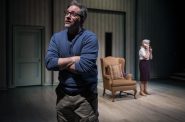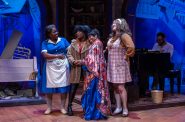The Rep’s Dan Kazemi puts the music in “Ragtime”
Kazemi, who helped Mark Clements launch the Rep's first musicals on the Quadracci Powerhouse, talks about crafting the epic sound of their latest show.

Dan Kazemi is a frequent musical director at the Rep, currently working on their fourth musical in the Quadracci Powerhouse, “Ragtime.”
This week, the Milwaukee Rep opens Ragtime, their fourth musical in as many years on the Quadracci Powerhouse. The Rep first started producing musical theater pieces with the arrival of artistic director Mark Clements, so it’s appropriate to give him credit for the innovative tweak to the company’s repertoire.
But without Dan Kazemi, that innovation might have been harder to come by. Kazemi, Ragtime’s musical director, has filled that role for all three of the Rep’s other Quadracci musicals (Cabaret, Next to Normal and Assassins) as well as Stackner Cabaret shows including Always… Patsy Cline and Blues in the Night. It was for Cabaret that he first came to the Rep, highly recommended to Clements by other directors at Philadelphia’s Walnut Street Theatre, where both had been working prior to Clements’ acceptance of the artistic director’s chair.
“It just kind of happened,” Kazemi said. “It was like it fell out of the sky, into my lap, and I got to come here and pioneer the musical theater program.”
Kazemi was originally just booked to do Cabaret, but he and Clements developed a rapport quickly. “Mark and I connected in an amazing way. We played to each other’s strengths and developed a really innate sense of trust in each other’s artistic vision. We can get a lot done together without any feelings hurt. … So it was smooth sailing, really.” By the time Cabaret was finished, he was on board to return for Next to Normal the following year, sparking the beginning of his relationship with the Rep.
This year, Kazemi will play a role in three other Rep productions: Forever Plaid, Ain’t Misbehavin’ and A Christmas Carol (vocal direction only). It’s a hefty load, but it should still fall under Kazemi’s original goal to only spend six months out of the year – the rest of the year, he returns to New York City, where he says he recently moved to help develop his career. Then again, it’s a rule he says he already broke in 2012 – although, he jokes, it shouldn’t count because it was in two different seasons.

“Ragtime” features the largest cast ever on the Quadracci Powerhouse, and Kazemi has built a virtual orchestra to complement it. All photos credit Michael Brosilow.
Of those four shows, though, Ragtime will almost certainly be the most complicated. It features the biggest cast – at more than 35 actors – that the Quadracci has ever seen. That cast depicts the members of three families in early 20th century-America (a wealthy upper class clan, a black couple and a father-daughter pair of immigrants) as well as a variety of historical figures, all intertwined in a tense culture clash. And yet its orchestra, saddled with a score as grandiose as the musical itself, totals only seven performers including Kazemi.
One danger pre-recorded orchestration usually presents is in its static nature – performers have to stay in line with the track, whereas a live orchestra can adjust as needed. But Kazemi’s thought of that too. At the beginning of the rehearsal process, he recorded multiple drafts of each recording, checking them against the performers’ own timing, resulting in a finished product custom-designed for each singer. In performance, Kazemi will be able to “fire” those tracks at will, or when more nuance and organic performance is needed, transition back to the live performers. “What you’re seeing every night in this piece is that puzzle coming together, of coming onto the track and jumping off of the track. … All the MIDI stuff melds perfectly into the thing that you hear. So yes, we don’t have another live trombone, but you’ll hear a lot of fake trombone. I’m telling you, I don’t think you’ll know. We’ve been very careful about that.”

Coalhouse Walker Jr. (Gavin Gregory, seated) is a performer of ragtime, but the events of the play ultimately pull him away from his musical pursuits.
That just leaves enjoying the music itself – which is, of course, a predominantly ragtime influenced score. “This is certainly a period piece, and you’re going to hear the sound of the period,” Kazemi said. “It’s very inspired by Scott Joplin.” But he added that there’s an appropriate touch of the modern musical theater in it too. “I see the influence of contemporary ‘80s, ‘90s music in this, somewhere buried deep. In the characters’ most operatic moments, it’s like contemporary musical theater world, where it’s a little bit like an ‘80s pop tune.”
Kazemi sees his role in the process to take that music – be it more ragtime or ‘80s or Broadway bombast – and use it to help tell the production’s story, rather than just glorify it for its own sake. “Making beautiful music, to me, is the easy part. Making beautiful music that tells a story that’s interesting and difficult and challenging and striving for clarity within that context is what’s really important to me.”
The Milwaukee Rep will open Ragtime, book adapted by Terrence McNally from E.L. Doctorow’s novel; music and lyrics by Steven Flaherty and Lynn Ahrens, this Saturday, Sept. 21. The show runs through Oct. 27; tickets range from $20 to $65 (prices subject to change), and can be ordered at (414) 224-9490 or at the Rep’s website.
Theater
-
‘The Treasurer’ a Darkly Funny Family Play
 Apr 29th, 2024 by Dominique Paul Noth
Apr 29th, 2024 by Dominique Paul Noth
-
Rep’s Nina Simone Play a Puzzle
 Apr 23rd, 2024 by Dominique Paul Noth
Apr 23rd, 2024 by Dominique Paul Noth
-
Skylight’s ‘Eternity’ Is a Slam Bang Show
 Apr 15th, 2024 by Dominique Paul Noth
Apr 15th, 2024 by Dominique Paul Noth





















